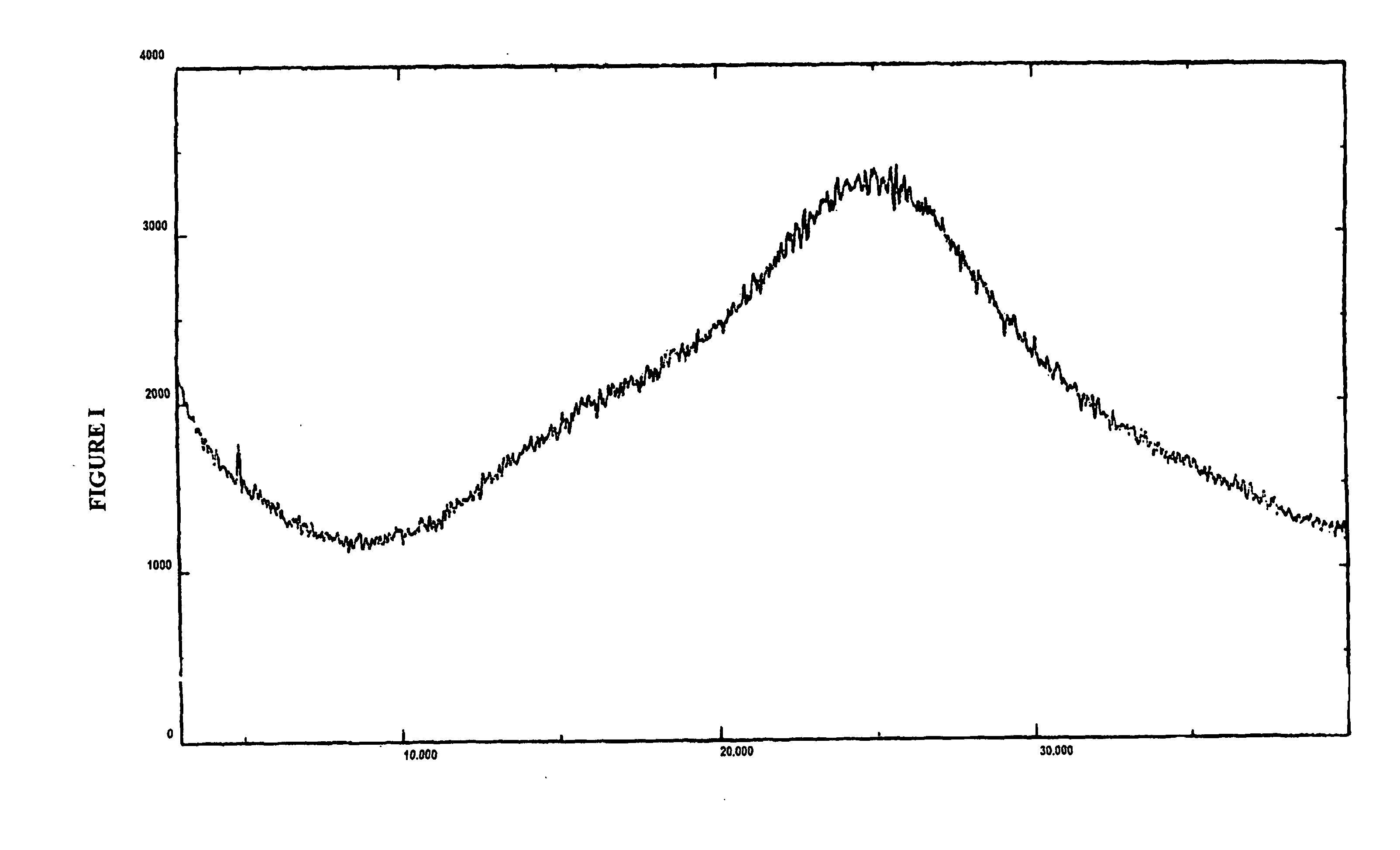Amorphous valganciclovir hydrochloride
a technology of valganciclovir and hydrochloride, which is applied in the field of amorphous form of valganciclovir hydrochloride, can solve the problems of patent disclosure of the utility and process of mono esters, and achieve the effect of superior stability profil
- Summary
- Abstract
- Description
- Claims
- Application Information
AI Technical Summary
Benefits of technology
Problems solved by technology
Method used
Image
Examples
example 1
Preparation of Amorphous Form of Valganciclovir from Reaction Mixture by Spray-Drying.
[0046] Mono CBZ-L-valine ganciclovir of Formula III (45 g) in ethanol (585 ml) was heated to get a clear solution followed by cooling to 40° C., formic acid was added (85%, 10.57 g), as well as water (58.5 ml) and palladium on carbon catalyst (5%, 50% wet, 7.5 g). The reaction mixture was stirred at 40-45° C., for 3-4 hrs. After completion of the reaction, the catalyst was removed by filtration through celite bed which was then washed with ethanol (45 ml). The filtrate was recovered at 25-35° C. under vacuum, and to the residue was added water (112 ml) and concentrated hydrochloric acid (9.3 ml). The mixture was filtered to remove undissolved material and the cake was washed with water (22.5 ml). To the clear filtrate was added IPA (96 ml) and the resultant mixture was warmed to 40° C. to get a clear solution. The clear solution was spray dried at 70-75° C., 6.0 kg nitrogen pressure and at a rate...
example 2
Conversions of Crystalline Form into Amorphous by Spray Drying.
Step a) Preparation of Crystalline Valganciclovir Hydrochloride
[0049] Mono CBZ-L-valine ganciclovir of Formula III (40 g) in ethanol (commercial, 500 ml) was heated to get a clear solution, followed by cooling to 40° C., formic acid was added (85%, 12.26 g), as well as water (50 ml) and palladium on carbon catalyst (5%, 50% wet, 8.0 g). The reaction mixture was stirred at 40-45° C., for 3-4 hrs. After completion of the reaction, the catalyst was removed by filtration through celite bed which was then washed with ethanol (20 ml). Added concentrated hydrochloric acid (8.3 ml) and the filtrate was concentrated completely at 25-35° C. under vacuum, and to the residue added ethanol absolute (100 ml) and recovered completely at 25-35° C. to remove water. To the concentrated mass added absolute ethanol (160 ml) and stirred at 25-30° C. for 1 hr. Filtered the solid and washed with absolute ethanol (30 ml). The product was dr...
example 3
Preparation of Mixture of Amorphous and Crystalline and its Conversion to Amorphous Form
Step a) Preparation of Mixture of Amorphous and Crystalline Valganciclovir Hydrochloride
[0053] Mono CBZ-L-valine ganciclovir of Formula III (45 g) in ethanol (commercial, 585 ml) was heated get a clear solution, followed by cooling to 40° C., formic acid was added (85%, 13.8 g), as well as water (58.5 ml) and palladium on carbon catalyst (5%, 50% wet, 10.12 g). The reaction mixture was stirred at 40-45° C., for 3-4 hrs. After completion of the reaction, the catalyst was removed by filtration through celite bed which was then washed with ethanol (20 ml). Concentrated hydrochloric acid was added (9.3 ml) and the filtrate was concentrated completely at 25-35° C. under vacuum, absolute ethanol was added (100 ml) and recovered at 25-35° C. to remove water. To the concentrated mass was added acetone (315 ml) and stirred at 25-30° C. for 12 hrs. The solid was filtered and washed with acetone (90 ml)...
PUM
| Property | Measurement | Unit |
|---|---|---|
| temperatures | aaaaa | aaaaa |
| temperatures | aaaaa | aaaaa |
| purity | aaaaa | aaaaa |
Abstract
Description
Claims
Application Information
 Login to View More
Login to View More - R&D
- Intellectual Property
- Life Sciences
- Materials
- Tech Scout
- Unparalleled Data Quality
- Higher Quality Content
- 60% Fewer Hallucinations
Browse by: Latest US Patents, China's latest patents, Technical Efficacy Thesaurus, Application Domain, Technology Topic, Popular Technical Reports.
© 2025 PatSnap. All rights reserved.Legal|Privacy policy|Modern Slavery Act Transparency Statement|Sitemap|About US| Contact US: help@patsnap.com



